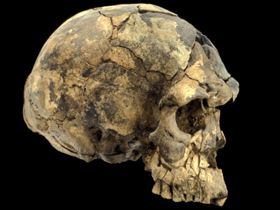 The remains of a 1.7 million-year-old stone hut, identical to structures still in use in various regions of Africa today |
The history of Homo sapiens, which represents modern man on the imaginary evolutionary family tree, goes back much further than evolutionists expected. Paleontological findings indicate that human beings identical to us were alive nearly a million years ago.
One of the discoveries in this regard is a fossil found in the Atapuerca region of Spain. The fact that this fossil has the same characteristics to those of modern man rocked evolutionist beliefs regarding the evolution of man. Because according to the evolutionary family tree, no Homo sapiens should have lived 800,000 years ago.
Indeed, many findings showed that H. sapiens goes back even further than 800,000 years. One of these was the discoveries made in Olduvai Gorge by Louis Leakey in the early 1970s. Leakey determined in the Bed II stratum that Australopithecus, Homo habilis and H. erectus had all lived there together and at the same time.
However, the really interesting thing was a structure—the remains of a stone hut—found by Leakey in that same stratum (Bed II). Its most interesting aspect was that such a structure, which is still in use in some African regions today, could have been made only by Homo sapiens! According to Leakey’s findings, Australopithecus, Homo habilis, H. erectus and modern man must all have been living together around 1.7 million years ago.209 This fact of course invalidates the theory of evolution that maintains that modern human beings evolved from the monkeys described as Australopithecus.
Moreover, there are findings of traces of modern human beings that go back even further than 1.7 million years. The most important of these is the footprints found in the Laetoli region. (See Laetoli footprints, the.) These prints, identical to those of modern human beings, have been calculated to date back some 3.6 million years.
These footprints discovered by Mary Leakey were later examined by such well-known paleoanthropologists as Don Johanson and Tim White.
Examinations of the morphological structure of the footprints again showed that they had to be regarded as belonging to a human and, what is more, to modern man, Homo sapiens. Russell Tuttle investigated the prints and later wrote:
A small barefoot Homo sapiens could have made them. . . In all discernible morphological features, the feet of the individuals that made the trails are indistinguishable from those of modern humans. 210
Unbiased investigations described the owners of these two sets of footprints: There was a total of 20 fossilized footprints belonging to a human being aged around 10, and 27 fossilized footprints belonging to someone slightly younger. They were very definitely normal human beings just like ourselves.
The fact that evolutionists persist in their theory that clearly conflicts with the scientific findings, and the way that they distort or ignore every discovery that works against it, clearly reveals that theory’s unscientific nature.
209 A. J. Kelso, Physical Anthropology, 1st Edition, 1970, p. 221; M. D. Leakey, Olduvai Gorge, Vol. 3, Cambridge: Cambridge University Press, 1971, p. 272.
210 I. Anderson, “Who made the Laetoli Footprints?” New Scientist, Vol. 98, 1983, p. 373.


